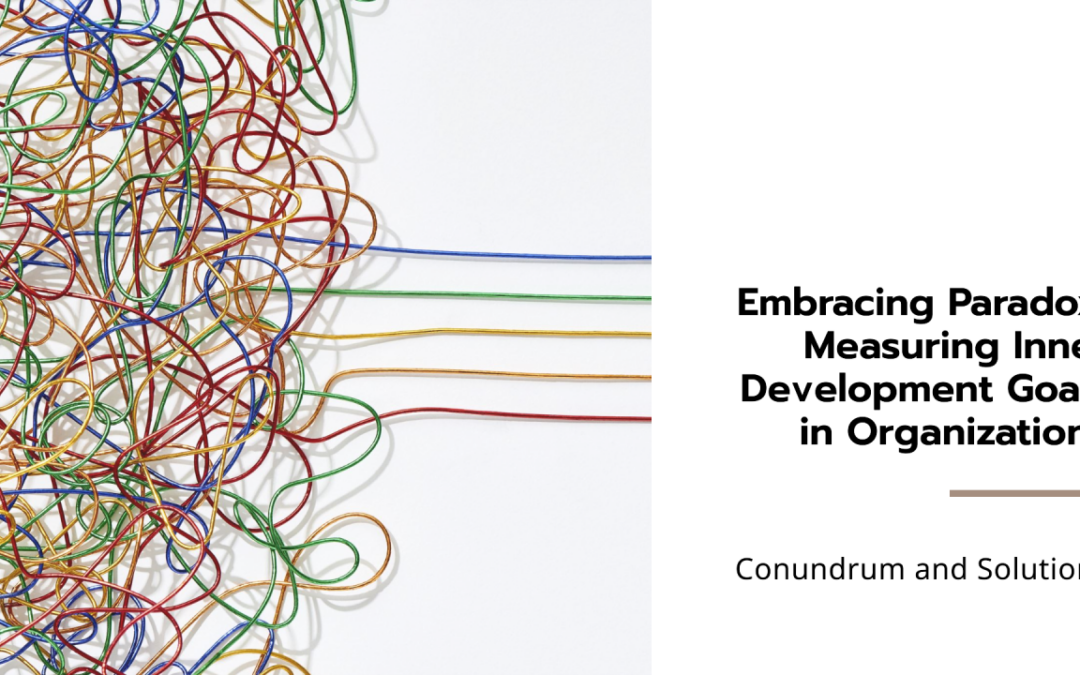The dilemma:
In our quest to drive adoption of Inner Development Goals in organizations, there exists a paradox that lies at the heart of our efforts:
On the one hand, IDGs exist to focus organizational attention on deeper human qualities such as compassion, creativity, and resilience. By embracing these goals, organizations can tap into a reservoir of unrealized potential, inspire their workforce, and elevate the impact of human contribution in a world of accelerating AI & automation.
However, on the other hand, we still live in a world where measurement precedes action. We’re all familiar with the mantra “What gets measured gets done.” This is especially true in the organizational context. It gets tricky though when dealing with inner development.
In our eagerness to quantify progress and demonstrate tangible outcomes, we risk reducing the richness of human experience to mere data points on a graph. By attempting to fit the subtle nuances of inner development into standardized metrics, we run the risk of losing sight of the essence of what makes these goals truly meaningful.
This dilemma mirrors the paradoxes inherent in the realm of quantum physics, where the more we strive for clarity, the more elusive it becomes. Author Alan Seale aptly captures this sentiment, noting that paradox is an intrinsic aspect of the quantum realm. Much like the early explorers of quantum physics, we find ourselves grappling with the enigmatic nature of our pursuit – to measure, or not to measure, inner development.
The opportunity:
So, how do we navigate this paradox and move beyond its confines? The answer lies in the power of “what if” questions – those mind opening inquiries that invite us to challenge conventional wisdom and explore new possibilities. What if we reframed our approach to measurement, what would that look like?
Ten years ago, I found myself pondering this exact “what if” question that would set the course for a transformative exploration:
“What if a measurement tool could be conceived in the ‘new realm,’ inviting the old realm to join it?”
Little did I know that this simple inquiry would kick start an entrepreneurial journey that would reshape my understanding of human development and how it can be effectively introduced and deployed at the individual, team and organizational level.
Here are some of the key lessons that I believe are instrumental in navigating the complexities of this endeavor:
The lessons:
1. Establish Relevance:
The first step in driving adoption of inner development in organizations is to establish their relevance and importance. Starting with the end in mind, it’s essential to articulate why it matters and how it aligns with the organization’s overarching goals and values. In the case of the IDGs, we can make powerful connections to the Sustainable Development Goals (SDGs). By first understanding what the organization wants to achieve at the SDG level, we can start enquiring about the human shifts needed to achieve them. This simple approach of “meeting our clients where they are at” can help connect the important dots between inner work and external results.
2. Position Measurement Tool:
It’s crucial to be crystal clear about the purpose and scope of the measurement tool used to assess Inner Development. Rather than viewing it as a means of evaluation, it should be positioned as a support tool for individual and team growth. Moreover, by reframing the tool as a conversation opener rather than an arbiter of truth, we invite a more nuanced and collaborative approach to interpreting the data. This fosters a greater sense of trust and openness among participants.
3. Best practices that align with the new paradigm:
- See people in their wholeness: When working with inner development the starting assumption is that people are already whole—a recognition of the inherent dignity and worth of every individual. Instead of focusing on deficits or shortcomings, the measurement highlights the extent to which IDGs are expressed or not expressed at a given point in time.
- Relative vs absolute: Furthermore, the tool embraces the notion that our growth is unlimited, acknowledging that there’s always room for further development and expansion, no matter how far we are on our inner development journey.
- Invites participation & co-creation: By inviting participation in the interpretation of the data we empower individuals and teams to take ownership of their insights and accountability for their next steps, fostering a culture of continuous learning and growth.
Conclusion:
In essence, my journey over the past decade has taught me that the deployment of IDGs in organizations requires a delicate balance of objectivity, compassion, and humility. By establishing relevance, positioning the measurement tool effectively, and embodying the characteristics of the new paradigm, we can create a fertile ground for transformative growth and evolution. As we continue to navigate the complexities of this journey, let us remain open to the possibilities that lie ahead and embrace the inherent paradoxes of human development. After all, it is in the embrace of paradox that true transformation happens.

